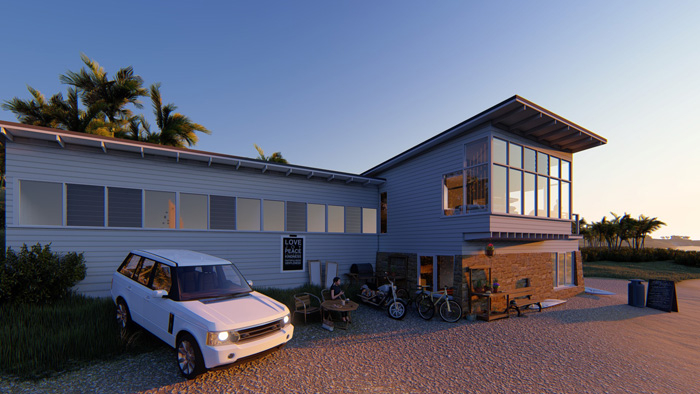AEC Magazine speaks with Lumion’s Roger Hammond about how real time rendering is changing the way architects think about and use design visualisation
Q: There’s currently huge momentum behind real time visualisation in the AEC sector. What benefits does ‘real time’ have over ray trace rendering, when stills or animations are rendered frame by frame?
A: The short answer is speed. But the benefits go much further than that. Using real time technology means being able to interact with your design in a life-like context in real time. You can perceive your design from any viewpoint and interact with it, viewing shadows, lighting and context in a way that allows you to understand and feel the space.
Real time technology enabled by dedicated graphics cards means you can build your scene in real time by adding animated trees, plants, people and objects to get a feel for how the design sits in its environment. This interactive experience is more vivid and informative than the traditional cumbersome design-render-consider-amend method, which involves a lot of waiting on renders and less emotional interaction with the space.
Real time interaction allows you to incorporate the visualisation process into the iterative design improvement process, leading to better designs and reduced time required to achieve the design. Producing high quality outputs very fast, enabled by real time technology, means that the client can get really enthusiastic about the design much earlier in the design process.

Q: Live links between BIM tools and real time viz applications are becoming more and more popular. In the last year Lumion has introduced a ‘LiveSync’ for Revit, SketchUp and ArchiCAD. How has this changed the way your customers use the software?
A: Designs are visualised in Lumion in a life-like environment but the designs themselves are created in BIM tools or other 3D modelling tools. The usual workflow involves saving a 3D design and then quickly importing it into Lumion. Updating already-imported models was quite an easy process which involved clicking a ‘refresh’ button in Lumion to re-import a saved 3D model file. But we discovered that typically, hundreds of small changes are made during the design process which can make saving and refreshing a little inefficient. Some designers prefer to see these changes appear in real time in Lumion, on the fly, as changes are made in the 3D modelling software, rather than going through a save-refresh cycle.
This is where the Lumion LiveSync innovation comes in. Open your 3D modelling software and Lumion side by side, either on the same monitor or two different ones, make changes to the model and see those changes immediately reflected in Lumion. In this way, LiveSync saves time and facilitates a more effective workflow.
Q: So, because of this optimised workflow, have you found that Lumion is now being used earlier on in the design process – at a stage where previously design viz may have not been considered as the design was much too fluid?
A: Yes. Lumion is being used especially in the early stages of design. Visualising and communicating design concepts is one of the biggest areas of Lumion use.
Q: The graphics requirements for Lumion are significantly higher than they are for a BIM tool like Revit. Have you found that workstation hardware is a barrier for adoption by architects as most Revit users only have a workstation with an entry-level graphics card?
A: Real time technology is enabled by good graphics cards. This has indeed proven to be a hardware barrier to the adoption of Lumion but things are changing. Price/performance of high-end graphics cards is becoming much more favourable as card technology improves, driven by gaming trends, which also rely on accelerated graphics technology. In some cases, we have seen architectural offices buying one or two additional PCs with good graphics cards, specifically for using Lumion. But as real time rendering becomes the norm in AEC, architects understand that graphics card specs are important when buying new desktops or laptops, and this means that in the coming few years, any new investments in hardware will likely take into account the need for a high-end graphics card.

Q: What specific graphics cards do you recommend – for those working on FHD and 4K displays?
A: We recommend getting the most powerful card that your budget will allow. We use the passmark website as a very useful reference in helping to decide on graphics cards: 2000 passmark points is the bare minimum requirement but we would recommend a card with above 8000 passmark points. For example the GeForce GTX 1080 Ti is a super card with excellent price-for-performance credentials.
Q: At AEC Magazine we are convinced that fully immersive, interactive VR is going to become an essential tool for architects in the coming years. It’s not currently available inside Lumion. Is there demand from customers and are they any plans to add support?
A: Our vision is to provide fast, high quality, out-of-the-box solutions, recognising that AEC professionals often have little time for training and usually need results quickly. The VR solutions currently available are pretty complicated to set up and the quality of the experience delivered is limited.
Many architecture practices also prefer to avoid walkthroughs and would rather show their design from specific viewpoints, enabling them to better tell their design story. That’s why a static VR immersive solution is currently supported in Lumion but a real time dynamic VR experience is not.
Lumion’s current 360 panorama output viewed through a suitable headset is an experience which is immersive enough for many architects. VR is still an emerging technology in AEC and a critical mass of users, especially in small and medium-sized architecture practices has yet to be convinced.
Aside from the above reasons, in our experience, accurately-rendered real time VR environments can be difficult to achieve, even using best-available graphics cards, sometimes leading to a less-than-optimal immersive experience. The communication process between architect and client can also be hindered, as the client becomes isolated from the local environment, when they put on their headset. Many small and medium-sized design and architecture firms rely on effective trouble-free communication with their clients and shifting to VR for them is, at the moment, not worth the effort.
Nevertheless, the Lumion team has a long history in VR technology, stretching back to even before Lumion and we continue to research the area. We are carefully following both the market and the hardware trends, so that we can continue to develop solutions which work best in practice.
Q: Following on from your point about architectural practices preferring to avoid walkthroughs, does this mean your customers tend to use Lumion to create videos, stills and 360 panoramas, rather than making client presentations interactive?
A: Exactly. The power of real time technology is not just about being able to build and experience the design in real time, but also to use the accelerated graphics power, which enables real time, to render outputs quickly. The speed of rendering changes the role of viz and the frequency of its use in the communication process between architects and their clients. For example, an architect told us that changes were made to his design just before he left to drive to a meeting with a client and by the time he arrived there, the adjusted renders were already in his inbox!
In short, real time technology (hardware combined with Lumion) has changed the game of communicating and understanding designs, by providing possibilities to the AEC industry which previously, were simply not available.

If you enjoyed this article, subscribe to AEC Magazine for FREE






